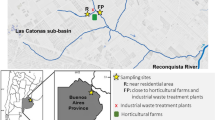Abstract
The effect of cholinergic antagonists on the bradycardia induced by waterborne copper in the Mediterranean limpet Patella caerulea was investigated by using non-invasive recording of cardiac activity of whole animals. Preliminary tests were conducted to check the role of cholinergic and serotoninergic systems in the control of heart rate of P. caerulea. Superfusing the whole limpets with carbachol (cholinergic agonist) at 5×10−5 M produced a negative inotropic and chronotropic effect (bradycardia), while superfusion with 5-hydroxytryptamine produced a positive inotropic and chronotropic effect (tachycardia). Exposure of limpets to a solution of copper in artificial seawater (0.25 mg l−1, 3 h) reduced their heart rate to about 80% the value recorded in copper-free water. This bradycardia was inhibited by injecting the limpets with atropine (cholinergic muscarinic antagonist) at 21 μg g−1 wet flesh weight and with benzoquinonium [cholinergic nicotinic antagonist blocking the K+ mediated acetylcholine (ACh) response] at 10 and 100 μg g−1 prior to copper exposure. In contrast, D-tubocurarine (cholinergic nicotinic antagonist blocking Na+ mediated ACh response) had no effect at 85 μg g−1. These results agree with the involvement of the cholinergic system in the bradycardic response of limpets to copper, and support the view that gastropod ACh receptors do not fit the vertebrate nicotinic–muscarinic classification.





Similar content being viewed by others
References
Chelazzi G, De Pirro M, Williams GA (2001) Cardiac responses to abiotic factors in two tropical limpets occurring at different levels of the shore. Mar Biol 139:1079–1085
Curtis TM, Williamson R, Depledge MH (2000) Simultaneous, long-term monitoring of valve and cardiac activity in the blue mussel Mytilus edulis exposed to copper. Mar Biol 136:837–846
Curtis TM, Williamson R, Depledge MH (2001) The initial mode of action of copper on the cardiac physiology of the blue mussel, Mytilus edulis. Aquat Toxicol 52:29–38
De Pirro M, Santini G, Chelazzi G (1999) Cardiac responses to salinity variations in two differently zoned Mediterranean limpets. J Comp Physiol B Biochem Syst Environ Physiol 169:501–506
De Pirro M, Chelazzi G, Borghini F, Focardi S (2001) Variations in cardiac activity following acute exposure to copper in three co-occurring but differently zoned Mediterranean limpets. Mar Pollut Bull 42:1390–1396
Depledge MH (1984a) Disruption of circulatory and respiratory activity in shore crabs (Carcinus maenas (L.)) exposed to heavy metal pollution. Comp Biochem Physiol 2:445–459
Depledge MH (1984b) Photoplethysmography—A non-invasive technique for monitoring heart beat and ventilation rate in decapod crustaceans. Comp Biochem Physiol 2:369–371
Depledge MH, Andersen BB (1990) A computer-aided physiological monitoring system for continuous, long-term recording of cardiac activity in selected invertebrates. Comp Biochem Physiol A 96:474–477
Depledge MH, Lundebye AK, Curtis T, Aagaard A, Andersen BD (1996) Automated interpulse-duration assessment (AIDA): a new technique for detecting disturbances in cardiac activity in selected macroinvertebrates. Mar Biol 126:313–319
Evans TG, Leake LD, Walker RJ (1971) The action of cholinergic drugs on the heart-beat of the limpet, Patella vulgata. Comp Gen Pharmacol 2:5–14
Goodman LS, Gilman A (2001) The pharmacological basis of therapeutics, 10th edn. McGraw-Hill Professional, New York
Greenberg MJ (1970) Comparison of acetylcholine structure-activity relations on the hearts of bivalve molluscs. Comp Biochem Physiol 33:259–294
Jones HD (1983) The circulatory systems of gastropods and bivalves. In: Saleuddin ASM, Wilbur KM (eds) The Mollusca, vol 5. Academic, London, pp 189–238
Leake LD, Walker RJ (1980) Invertebrate neuropharmacology. Blackie, Bishopbriggs, Glasgow, UK
Leake LD, Evans TG, Walker RJ (1971) The role of catecholamines and 5-hydroxytryptamine on the heart of Patella vulgata. Comp Gen Pharmacol 2:151–158
Leake LD, Evans TG, Walker RJ (1975) Evidence for the presence of 5-hydroxytryptamine, dopamine and acetylcholine in the nervous system and heart of the limpet, Patella vulgata. Comp Biochem Physiol C 51:205–213
Marchán S, Davies MS, Fleming S, Jones HD (1999) Effects of copper and zinc on the heart rate of limpet Patella vulgata L. Comp Biochem Physiol A 123:89–93
Marshall DJ, McQuaid CD (1993) Effects of hypoxia and hyposalinity on the heart beat of the intertidal limpets Patella granularis (Prosobranchia) and Siphonaria capensis (Pulmonata). Comp Biochem Physiol A 106:65–68
McMahon BR, Wilkens JL, Smith PJS (1997) Invertebrate circulatory systems. In: Dantzler WH (ed) Handbook of physiology, section 13. Comparative physiology, vol 2. Oxford University Press, New York, pp 931–1008
Pereira EFR, Reinhardt-Maelicke S, Schrattenholz A, Maelicke A, Albuquerque EX (1993) Identification of functional characterization of a new agonist site on nicotinic acetylcholine receptors of cultured hippocampal neurons. J Pharmacol Exp Ther 265:1474–1483
Zhuravlev VL (1999) Mechanisms of neurohumoral control of the heart in gastropods. J Evol Biochem Physiol 35:85–103
Author information
Authors and Affiliations
Corresponding author
Additional information
Communicated by R. Cattaneo-Vietti, Genova
Rights and permissions
About this article
Cite this article
Pugliese, A.M., Bini, G., De Pirro, M. et al. Effect of cholinergic antagonists on the bradycardic response of limpets to copper. Marine Biology 144, 955–960 (2004). https://doi.org/10.1007/s00227-003-1253-y
Received:
Accepted:
Published:
Issue Date:
DOI: https://doi.org/10.1007/s00227-003-1253-y




